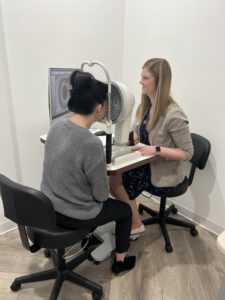
Dr. Kuzniar with a staff member demonstrating how she works with specialty contact lens patients. She says that moving these patients smoothly through the office requires an organized system.
By Jamie Kuzniar, OD
Feb. 8, 2023
Specialty contact lenses change lives and can catapult practice profitability to new heights. Specialty contact lens patients, however, require more time than traditional, single-vision soft contact lens patients.
I helped to build a specialty lens niche within a primary care practice that grew to generate almost half of my production on reduced patient care days. Here is what I learned from that experience about managing specialty contact lens patient flow, which I am now applying to my new practice.
How Much Time Do I Set Aside?
I set aside 45 minutes for each specialty lens patient to allow for fitting the lenses, taking all necessary measurements and inputting the long medical history of the typical specialty lens patient. A traditional contact lens patient will typically only need 30 minutes at my office. If you have the proper staff resources, this time could be condensed even further as you grow.
How Do I Prepare Myself & Manage Exam Room Time?
I review records before the patient arrives if they are being referred in, then we take a detailed history about their condition and all contact lenses worn in the past. It is essential to receive the referral records ahead of time to review before the initial fitting and consultation.
Next, we do pretesting, including corneal topography, and go over the best lens option for the patient and any out-of-pocket payments required.
Next, we begin fitting by placing diagnostic lenses on the patient’s eyes and taking detailed measurements. At the conclusion of the visit I summarize all of my findings again and estimate the time it will take for their lenses to arrive. My staff will then coordinate all dispense and follow-up appointments, as well as answer any additional questions.
You can easily streamline time with specialty patients into your everyday routine. For example, when I first apply the specialty lenses on the patient’s eyes, I let the lenses settle, and can see another patient in between in another exam room to keep my schedule flowing. I also delegate application and removal training to one of my employees, so I can see other patients while the patient still receives one-on-one care. Application and removal training can often take up to one hour, and is not worth the chair time for the doctor to sit with the patient the entire time.
Weave In Patient Education Throughout Visit
I try to provide patient education throughout the patient’s initial appointment, first after taking initial pretest data and again at the end of the appointment. It is helpful to have handouts or videos for the patient to review at home since there is a lot of information presented to specialty patients during their initial visit.
At their follow-up visits, I always ask patients if they have any questions that occurred to them after their last visit or during the first few weeks of wearing their new lenses.
If You Can, Devote Specific Time(s) for Specialty CL Patients
I set aside one day per week for specialty patients only, so that I can move through dispenses, fittings and follow-ups without having routine exams in the middle. When a specialty contact lens patient cannot come in on that particular day, however, I am flexible since patients may have restrictions in their schedule due to work and family responsibilities.
Other Articles to Explore
Pinpoint Cause of Patient Bottlenecks So They Don’t Happen
The typical bottleneck can occur when taking the history of a specialty lens patient who has a complex history. I try to avoid this in my office by steering the conversation back on track and asking direct questions about their history that are most pertinent.
Another bottleneck can occur if it is difficult to insert the initial diagnostic trial lens due to either lack of patient cooperation or fear of wearing lenses. When this happens, I allow a support staff member to work with the patient individually until they can apply the lens themselves. This is a good approach since they will need to learn how to apply the lens themselves eventually.
Manage Follow-up Care & Needs
At minimum, specialty contact lens patients will have three visits: the initial fitting, the dispense appointment, then a follow-up after wearing their new lenses. If we are making changes, it can add on a couple of visits to ensure the changes made to the lens have solved any problems the patient had with the initial lens.
If I am making a small change to the lens, I will often direct-ship the adjusted lens to the patient or have them pick up the new lens from the office without an appointment and have their follow-up prescheduled, so they have been wearing the new lenses for about a week by the time I see them. This saves a dispense appointment if you are just making a small change to the fit or a power change.
It is important to preschedule patients at their dispense for follow-up appointments, so your staff does not have to call and schedule appointments when the lenses arrive. It is important to capture the patient for return visits while they are in the office instead of trying to track them down later with multiple calls and texts.
With the right preparations and office systems, even an office with a high volume of specialty contact lens patients can stay efficient and on-time.
 Jamie Kuzniar, OD, is the owner of Elevate Eye Care + Eyewear in Rochester Hills, Mich. To contact her: jamiekuzniarod@gmail.com
Jamie Kuzniar, OD, is the owner of Elevate Eye Care + Eyewear in Rochester Hills, Mich. To contact her: jamiekuzniarod@gmail.com

























